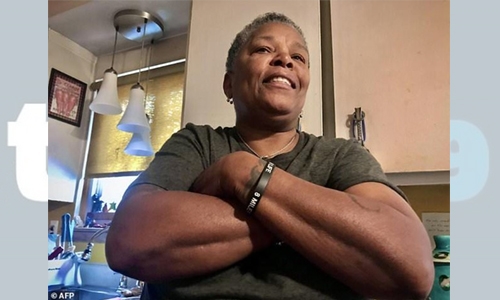Life on Detroit’s 8 Mile Wall
As a child living in Detroit, Teresa Moon didn’t know anything about the concrete stone wall she could see from the kitchen window in her family’s home. Sixty years on, in that same kitchen, she knows all about the Birwood Wall, or the 8 Mile Wall, which was built in the 1940s to separate her black neighborhood from a housing project aimed at white families.
“We live in a community that is about building confidence, about ownership about being proud of who you are. Why would my parents tell me something about that?” Moon confides, haltingly. “That would kind of dispel all that -- like, I got a wall to keep me separate from other people,” said the charismatic 66-year-old former city worker.
Moon has become something of the spokeswoman for the “8 Mile” neighborhood -- named for the road that long separated the predominantly black city from the mainly white suburbs. 8 Mile earned pop culture fame thanks to white rapper Eminem, whose biopic was named for the neighborhood.
But, Moon points out, he wasn’t from the area - - he grew up in the nearby city of Warren. “A lot of people claim 8 Mile because it’s something to claim,” she says.
Not an accident
The entire Detroit area was propelled for decades by the auto industry, but Motor City is now one of the poorest major urban centers in America. Moon moved to 8 Mile when she was six, at a time when racial segregation was still the norm in the United States.
Despite the signing of the Emancipation Proclamation and the constitutional abolition of slavery in America, laws remained in place that mandated the separation of races. In some states, those laws remained in effect in the late 1950s and 1960s. But even after that, the specter of segregation effectively kept some places segregated for decades to follow.
Some still are separated.
“Detroit is the most segregated metropolitan area in the country,” says Eric Williams, a lawyer for the non-profit Detroit Justice Center. “That doesn’t happen by accident. It just doesn’t. (...) There are tons of neighborhoods in Detroit that just simply did not allow black people to live there.” Blacks couldn’t ‘become more’ Moon recalls that when her family moved to their home in 8 Mile, seven of them had to live in three rooms.
She only met white kids for the first time when she went to junior high school. “That’s the first time I interacted with white people in my life. I only saw them on TV” before that, she said. In her kitchen, she opens up an issue of Collier’s magazine, from 1946, and points at a picture of black children sitting along the Birwood Wall, while on the other side, white teenagers are playing. The wall is about six feet high (1.8 meters) and easily scaled.
But the barrier it posed was clear-cut. “The government wouldn’t insure white owners’ mortgages until a wall separating Negroes was put up,” read the caption under the photo in Collier’s. Detroit’s black 8 Mile neighborhood had already existed for decades. But in the midst of a postwar housing boom, developers were attracted to the area, and wanted to build a white neighborhood.
“That was the concept -- if you live near black people, then your neighborhood is never going to be good. So let’s build a wall,” explains Moon. After a lengthy silence, she summarized the notion, calling it “crazy” -- and emotionally punctuating her thought with an expletive.
On her family’s side of the wall, “black people couldn’t get mortgages, black people couldn’t get loans, black people couldn’t... you know, become more, couldn’t develop wealth like generational wealth -- couldn’t get nothing,” she said. The situation left people thinking “black people can’t do anything.
They never thought a black man would be the president of the United States,” said Moon -- Barack Obama is among the many faces that decorate her kitchen.
‘A pride thing’
The wall has more than just bad memories: Moon also remembers playing there with her friends. Scaling it was something of a rite of passage. She never tried it, she says with a smile. At age 13 or 14, she finally understood why it was there. “Just to learn the disparities that the people of my colour had to live through because of the color of our skin... was crazy to me,” she said.
Today, the neighborhood is still “98, 99 percent” black, Moon notes. The downturn in the auto industry, the financial crisis of a decade ago and Detroit’s municipal bankruptcy in 2013 did not make things any easier for residents. The wall is now in a freshly redone park for children.
Artists and locals covered it with colorful murals in 2006, depicting key moments in the history of the site. It has been designated a historic landmark. Above all, Moon explains, being from 8 Mile is “a pride thing.” “Detroit is a very poor city,” she says. But 8 Mile “has always been a very strong and committed and loving place to live. So that’s why I’m still here.”
Related Posts

